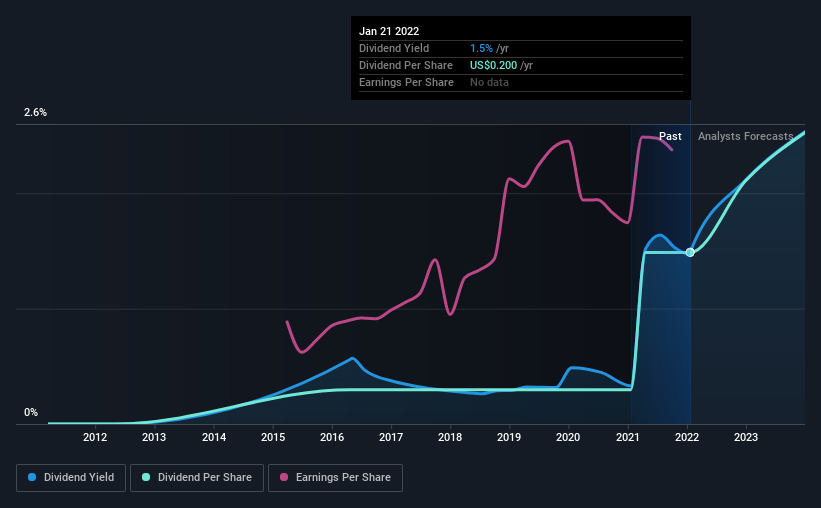Why You Might Be Interested In Old Second Bancorp, Inc. (NASDAQ:OSBC) For Its Upcoming Dividend
Some investors rely on dividends for growing their wealth, and if you're one of those dividend sleuths, you might be intrigued to know that Old Second Bancorp, Inc. (NASDAQ:OSBC) is about to go ex-dividend in just 4 days. Typically, the ex-dividend date is one business day before the record date which is the date on which a company determines the shareholders eligible to receive a dividend. The ex-dividend date is important as the process of settlement involves two full business days. So if you miss that date, you would not show up on the company's books on the record date. Accordingly, Old Second Bancorp investors that purchase the stock on or after the 27th of January will not receive the dividend, which will be paid on the 7th of February.
The company's next dividend payment will be US$0.05 per share, on the back of last year when the company paid a total of US$0.20 to shareholders. Last year's total dividend payments show that Old Second Bancorp has a trailing yield of 1.5% on the current share price of $13.42. If you buy this business for its dividend, you should have an idea of whether Old Second Bancorp's dividend is reliable and sustainable. So we need to investigate whether Old Second Bancorp can afford its dividend, and if the dividend could grow.
Check out our latest analysis for Old Second Bancorp
Dividends are typically paid from company earnings. If a company pays more in dividends than it earned in profit, then the dividend could be unsustainable. Old Second Bancorp is paying out just 9.4% of its profit after tax, which is comfortably low and leaves plenty of breathing room in the case of adverse events.
Generally speaking, the lower a company's payout ratios, the more resilient its dividend usually is.
Click here to see the company's payout ratio, plus analyst estimates of its future dividends.
Have Earnings And Dividends Been Growing?
Companies with consistently growing earnings per share generally make the best dividend stocks, as they usually find it easier to grow dividends per share. If earnings fall far enough, the company could be forced to cut its dividend. For this reason, we're glad to see Old Second Bancorp's earnings per share have risen 12% per annum over the last five years.
The main way most investors will assess a company's dividend prospects is by checking the historical rate of dividend growth. Old Second Bancorp has delivered an average of 31% per year annual increase in its dividend, based on the past six years of dividend payments. Both per-share earnings and dividends have both been growing rapidly in recent times, which is great to see.
To Sum It Up
Is Old Second Bancorp worth buying for its dividend? Companies like Old Second Bancorp that are growing rapidly and paying out a low fraction of earnings, are usually reinvesting heavily in their business. Perhaps even more importantly - this can sometimes signal management is focused on the long term future of the business. We think this is a pretty attractive combination, and would be interested in investigating Old Second Bancorp more closely.
While it's tempting to invest in Old Second Bancorp for the dividends alone, you should always be mindful of the risks involved. To that end, you should learn about the 3 warning signs we've spotted with Old Second Bancorp (including 1 which doesn't sit too well with us).
If you're in the market for dividend stocks, we recommend checking our list of top dividend stocks with a greater than 2% yield and an upcoming dividend.
Have feedback on this article? Concerned about the content? Get in touch with us directly. Alternatively, email editorial-team (at) simplywallst.com.
This article by Simply Wall St is general in nature. We provide commentary based on historical data and analyst forecasts only using an unbiased methodology and our articles are not intended to be financial advice. It does not constitute a recommendation to buy or sell any stock, and does not take account of your objectives, or your financial situation. We aim to bring you long-term focused analysis driven by fundamental data. Note that our analysis may not factor in the latest price-sensitive company announcements or qualitative material. Simply Wall St has no position in any stocks mentioned.

